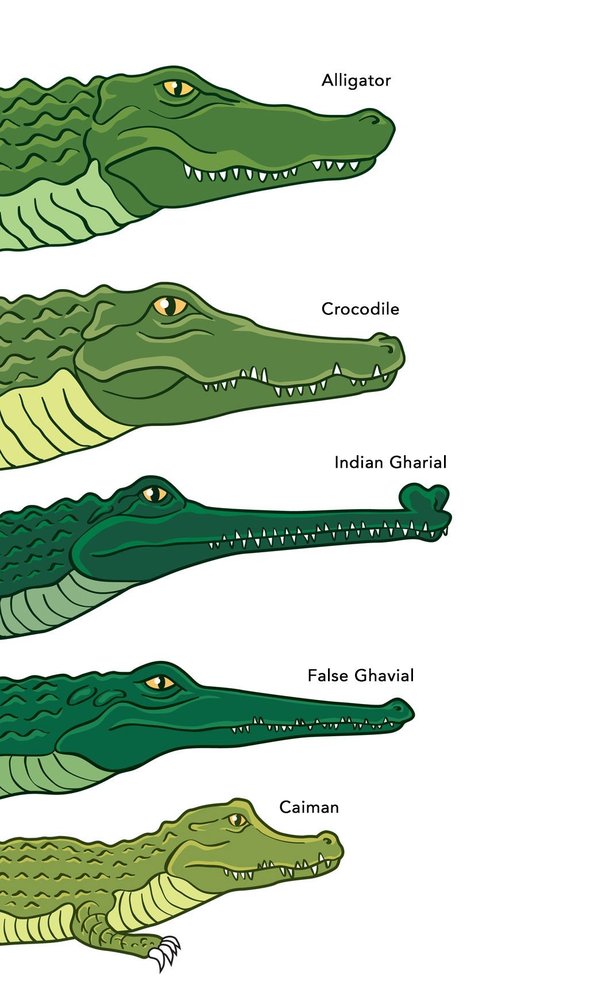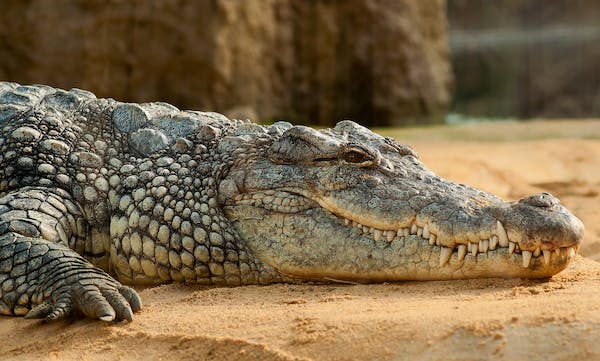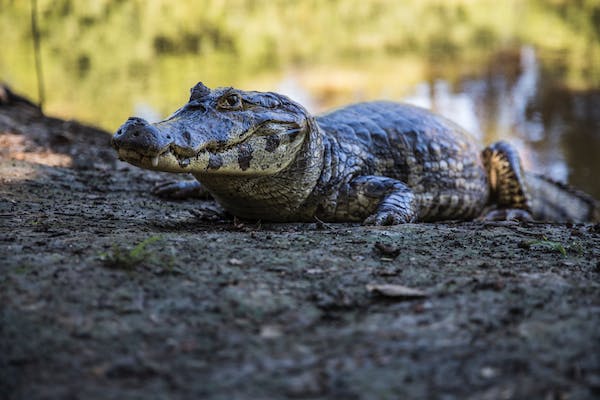Comparing Crocodilian Species (Differences): Crocodile vs. Alligator vs. Gharial vs. Caiman
Crocodilians are a diverse group of ancient reptiles that have captured human fascination for centuries. These reptiles, which include crocodiles, alligators, gharials, and caimans, exhibit a wide array of unique characteristics, behaviors, and adaptations. In this blog, we’ll take an in-depth look at each of these four crocodilian species and highlight their key differences.

Crocodiles, alligators, gharials, and caimans are all members of the Crocodylia order, but they belong to different families and have distinct characteristics. Here’s a breakdown of the differences among them:
Crocodiles (Family: Crocodylidae):
- Physical Characteristics: Crocodiles generally have a V-shaped snout that is more pointed and narrower than that of alligators. They also have a fourth tooth visible when their mouths are closed.
- Habitat: Crocodiles are found in a variety of habitats, including freshwater and saltwater environments. They can tolerate saltwater well and are often found in coastal regions.
- Geographical Range: Crocodiles have a wide distribution and are found in Africa, the Americas, Asia, and Australia.
- Behavior: Crocodiles tend to be more aggressive than alligators and have been known to venture into open seas more frequently.

Alligators (Family: Alligatoridae):
- Physical Characteristics: Alligators have a U-shaped snout that is wider and more rounded than that of crocodiles. Their upper jaw overlaps their lower jaw, so their teeth are mostly hidden when their mouths are closed.
- Habitat: Alligators are commonly found in freshwater environments, such as swamps, marshes, and rivers.
- Geographical Range: Alligators are native to the southeastern United States and China.
- Behavior: Alligators are generally considered less aggressive than crocodiles and are more tolerant of cooler temperatures.

Gharials (Family: Gavialidae):
- Physical Characteristics: Gharials are known for their long, narrow snouts that are adapted for catching fish. Adult gharials have distinctive knobs on the end of their snouts.
- Habitat: Gharials inhabit freshwater rivers in parts of India and Nepal. They prefer clear, fast-flowing water.
- Geographical Range: Gharials are native to the Indian subcontinent, primarily in the Ganges and Brahmaputra river basins.
- Behavior: Gharials mainly feed on fish and have specialized jaws for catching them. They are generally not considered a threat to humans.

Caimans (Family: Alligatoridae):
- Physical Characteristics: Caimans have a snout shape that falls between that of crocodiles and alligators. Their snouts are broader than those of gharials but narrower than those of crocodiles.
- Habitat: Caimans are found in Central and South America, inhabiting a range of freshwater habitats like rivers, lakes, and swamps.
- Geographical Range: Caimans are native to Central and South America.
- Behavior: Caimans, like alligators, are generally less aggressive than crocodiles. They are adapted to their local environments and play important roles in their ecosystems.

Here’s a table outlining the key differences between crocodiles, alligators, gharials, and caimans:
| Characteristic | Crocodile | Alligator | Gharial | Caiman |
|---|---|---|---|---|
| Snout Shape | V-shaped, pointed | U-shaped, rounded | Long, narrow | Between crocodile & alligator |
| Jaw Overlap | Fourth tooth visible | Upper overlaps lower | No overlap | Upper overlaps lower |
| Habitat | Freshwater & Saltwater | Freshwater | Freshwater rivers | Freshwater |
| Geographical Range | Africa, Americas, Asia, Australia | Southeastern US, China | India, Nepal | Central & South America |
| Aggressiveness | More aggressive | Less aggressive | Not aggressive | Less aggressive |
| Diet | Varied, opportunistic | Varied, opportunistic | Fish | Varied, opportunistic |
| Notable Features | Tolerate saltwater | Tolerate cooler temps | Knobs on snout | Adapted to local environments |
Ecosystem Roles:
Comparing the Roles of Crocodiles, Alligators, Gharials, and Caimans:
Each of these crocodilian species plays a unique role in its ecosystem. Crocodiles, with their position as apex predators, help regulate prey populations and maintain ecosystem balance. Alligators create crucial habitats by digging out depressions that collect water and provide refuge for various species. Gharials’ fish-focused diet can help control fish populations and maintain aquatic ecosystems. Caimans, too, impact local food webs by influencing prey populations and acting as a link between aquatic and terrestrial ecosystems.
In conclusion, the world of crocodilians is a captivating realm of diversity, adaptation, and ecological significance. Each species—crocodile, alligator, gharial, and caiman—brings its own unique traits and behaviors, contributing to the rich tapestry of life in their respective habitats. Understanding these differences not only enhances our appreciation for the natural world but also sheds light on the delicate balance of ecosystems they inhabit.
61 thoughts on “Comparing Crocodilian Species (Differences): Crocodile vs. Alligator vs. Gharial vs. Caiman”
Hey! I know this is kinda off topic however , I’d figured I’d ask. Would you be interested in exchanging links or maybe guest authoring a blog post or vice-versa? My website covers a lot of the same topics as yours and I feel we could greatly benefit from each other. If you are interested feel free to shoot me an email. I look forward to hearing from you! Fantastic blog by the way!
Wow that was unusual. I just wrote an very long comment but after I clicked submit my comment didn’t appear. Grrrr… well I’m not writing all that over again. Anyway, just wanted to say wonderful blog!
I loved as much as you’ll receive carried out right here. The sketch is attractive, your authored material stylish. nonetheless, you command get bought an shakiness over that you wish be delivering the following. unwell unquestionably come more formerly again since exactly the same nearly very often inside case you shield this increase.
A person essentially help to make seriously posts I would state. This is the very first time I frequented your website page and thus far? I amazed with the research you made to make this particular publish amazing. Great job!
thank you
Thanks for your personal marvelous posting! I genuinely
enjoyed reading it, youu are a great author. I wikl make certai to bookmark your blog and definitely will come back very soon. I want to encourage that you
continue your great posts, have a nice holiday weekend! https://www.waste-ndc.pro/community/profile/tressa79906983/
I have been browsing online more than three hours today, yet
I never found any interesting article like yours.
It is pretty worth enough for me. Personally, if all web owners and bloggers made
good content as you did, the internet will be much more useful than ever before.
What’s up mates, pleasant paragraph and pleasant urging commented here,
I am truly enjoying by these.
Great insights! I found your take on sustainable living incredibly practical. Looking forward to implementing some of these tips! Check out [Get Info](https://getinfo.ink) for more inspiring content.
Good post. I study one thing tougher on different blogs everyday. It’ll at all times be stimulating to learn content from other writers and observe a little bit one thing from their store. I’d desire to use some with the content material on my weblog whether or not you don’t mind. Natually I’ll give you a hyperlink in your web blog. Thanks for sharing.
Attractive section of content. I just stumbled upon your web site and in accession capital to assert that I acquire in fact enjoyed account your blog posts. Anyway I will be subscribing to your feeds and even I achievement you access consistently quickly.
Thank you for another informative blog. Where else could I get that type of info written in such a perfect way? I’ve a project that I’m just now working on, and I have been on the look out for such info.
whoah this weblog is great i like reading your posts. Stay up the good work! You know, lots of individuals are searching around for this information, you could aid them greatly.
I like what you guys are up also. Such clever work and reporting! Keep up the excellent works guys I’ve incorporated you guys to my blogroll. I think it’ll improve the value of my web site 🙂
I do agree with all the ideas you have presented for your post. They are very convincing and will definitely work. Nonetheless, the posts are very short for starters. May just you please prolong them a little from next time? Thanks for the post.
I’m really impressed with your writing skills as well as with the layout on your weblog. Is this a paid theme or did you customize it yourself? Either way keep up the excellent quality writing, it is rare to see a great blog like this one nowadays..
keep up the great piece of work, I read few blog posts on this internet site and I conceive that your site is very interesting and contains circles of great info .
A great post without any doubt.
Thank you!
some genuinely nice and useful information on this internet site, likewise I conceive the pattern holds fantastic features.
You made some respectable factors there. I seemed on the internet for the issue and located most individuals will go along with together with your website.
Thank you so much for sharing this wonderful post with us.
glad to be one of several visitors on this awful internet site : D.
The information shared is of top quality which has to get appreciated at all levels. Well done…
Thank you so much for sharing this wonderful post with us.
Nice i really enjoyed reading your blogs. Keep on posting. Thanks
The information shared is of top quality which has to get appreciated at all levels. Well done…
The information shared is of top quality which has to get appreciated at all levels. Well done…
Thank you so much for sharing this wonderful post with us.
Thank you for sharing indeed great looking !
Nice i really enjoyed reading your blogs. Keep on posting. Thanks
A great post without any doubt.
The information shared is of top quality which has to get appreciated at all levels. Well done…
Thank you for sharing indeed great looking !
Thank you so much for sharing this wonderful post with us.
A great post without any doubt.
The information shared is of top quality which has to get appreciated at all levels. Well done…
The information shared is of top quality which has to get appreciated at all levels. Well done…
Thank you so much for sharing this wonderful post with us.
Thank you for sharing indeed great looking !
Nice i really enjoyed reading your blogs. Keep on posting. Thanks
Nice i really enjoyed reading your blogs. Keep on posting. Thanks
Thank you for sharing indeed great looking !
very nice put up, i definitely love this website, carry on it
Nice i really enjoyed reading your blogs. Keep on posting. Thanks
A great post without any doubt.
Way cool! Some very valid points! I appreciate you writing this write-up plus the rest of the site is also very good.
Of course, what a great site and informative posts, I will bookmark your site.All the Best!
A large percentage of of whatever you mention happens to be astonishingly accurate and that makes me ponder why I hadn’t looked at this in this light previously. This particular article truly did switch the light on for me as far as this particular subject goes. Nonetheless there is 1 issue I am not really too comfortable with and while I attempt to reconcile that with the actual main theme of the point, let me observe just what the rest of the subscribers have to say.Well done.
Nice i really enjoyed reading your blogs. Keep on posting. Thanks
Right here is the right site for anybody who wishes to find out about this topic. You understand a whole lot its almost tough to argue with you (not that I actually will need to…HaHa). You certainly put a brand new spin on a subject that’s been written about for a long time. Excellent stuff, just wonderful.
Thank you
There’s certainly a lot to find out about this issue. I love all the points you have made.
We’re a group of volunteers and starting a brand new scheme in our community. Your site offered us with helpful info to paintings on. You have done a formidable task and our whole neighborhood will probably be grateful to you.
I’m glad I found this blog. Amazing content!
Magnificent goods from you, man. I’ve understand your stuff previous to and you’re just too great.
I really like what you’ve acquired here, really like what you’re stating and the way in which
you say it. You make it enjoyable and you still care for to
keep it wise. I can not wait to read much more
from you. This is really a tremendous website. https://kesq.com/stacker-money/2022/12/15/youngest-billionaires-in-america/
Magnificent goods from you, man. I’ve understand your stuff previous to and you’re just too great.
I really like what you’ve acquired here, really like what you’re stating and the way
in which you say it. You make it enjoyable and you still
care for to keep it wise. I can not wait to read much more from you.
This is really a tremendous website. https://kesq.com/stacker-money/2022/12/15/youngest-billionaires-in-america/
Quality posts is the key to interest the viewers to pay
a visit the web page, that’s what this website is providing. https://endoskopiemitwiscope.wordpress.com/
Excellent website. A lot of helpful information here.
I am sending it to several friends ans also sharing in delicious.
And obviously, thanks for your effort!
I don’t even know how I ended up here, however I thought this put up used to be good.
I do not understand who you are however certainly you’re going to a famous blogger if
you happen to aren’t already. Cheers! https://www.wcjb.com/2025/02/19/aarp-issues-warning-over-crypto-atm-scams/
Thanks for making a complex topic actually easy to grasp.